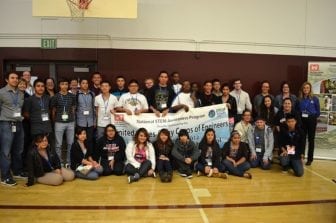
July 3, 2018; Education Dive
From 2009 through 2013, Jonathan Raymond was Superintendent of Schools in Sacramento, California. At the time he left, the school district was the state’s twelfth-largest, with 42,000 students. Today, the school district has grown slightly and has become the state’s tenth-largest district, with an estimated 43,000 students. Since July 2014, Raymond has headed the Stuart Foundation, a philanthropy based in San Francisco that works with public school districts to promote a “whole child” approach to education—that is, an approach that embeds academics for children with social supports that enhance their physical and emotional health and safety. Recently, Raymond authored a book on his educational philosophy titled Wildflowers.
In Education Dive, Linda Jacobson observes that Raymond’s work over “more than four years in Sacramento included a focus on social-emotional learning, the development of a home-visiting model that is now spreading across the country, success at lowering the dropout rate, and, especially, his ‘priority schools initiative,’ a turnaround effort involving seven low-performing schools.” That said, Raymond’s tenure in Sacramento was hardly without controversy.
As Raymond prepared to step down in December 2013, John Festerwald wrote in EdSource that Raymond departed “with a credible list of accomplishments at least partly attributable to his leadership.” These included “implementing Common Core standards, greatly expanded summer programs, new college and career programs tied to businesses and the community, home-school visits [and]…a new focus on social and emotional aspects of learning.”
That said, relations with the teachers’ union were tense. Festerwald remarks that, “Raymond [was] openly disdainful of the union, and vice versa.” When Raymond’s replacement was named several months after his departure, Loretta Kalb in the Sacramento Bee observed that it was “a shift welcomed by a teachers’ union still frosted about Raymond’s policies and neighborhood advocates alienated over last year’s closure of seven elementary campuses in low-income areas.”
In an interview with Jacobson, Raymond speaks about his educational philosophy. At the same time, he openly acknowledges some of his missteps in Sacramento.
Sign up for our free newsletters
Subscribe to NPQ's newsletters to have our top stories delivered directly to your inbox.
By signing up, you agree to our privacy policy and terms of use, and to receive messages from NPQ and our partners.
According to Raymond, his overall education philosophy is based on “hope, belief and community. With hope, we inspire and energize others to be and lead the change we want to see. When we believe in children, and give them presence and voice, we inspire them to dream and reach beyond their current reality. When we engage community, we create the social safety nets and supports, so every child can reach their potential. Change is possible when we realize that education goes beyond the integration of head and hand. Change comes from the heart, and the road to excellence in public education lies at the crossroads of empathy and academic learning.”
One of Raymond’s more controversial initiatives in Sacramento involved an effort to “transform some of our neediest and most disadvantaged schools in the spring of 2010—what later become our Superintendent’s Priority School Initiative.” Raymond notes that he and his team opted against the conventional approach of converting failing schools into charter schools and instead launched the initiative “with our own principals and teachers.” Raymond adds that the district “relied upon proven pillars such as building and supporting collaborative teams of educators…and engaging and empowering parents and families, starting with home visits.”
This became highly controversial, however, when the district, according to Raymond, employed a “rarely used provision in the California Education Code” to protect low-seniority teachers who were part of the Priority Schools Initiative from being laid off. This decision likely benefitted the Priority Schools, but other teachers with greater seniority faced layoffs. (The union sued, but the district prevailed in court.)
“What do you wish you could have done differently?” Jacobson asks. Raymond stops short of saying he would have avoided the layoffs, but he concedes that he “could have worked harder to build stronger relationships with our local teachers’ union leadership.”
Raymond also identified other areas where he would have acted differently:
- Human resources: “I never managed to get the right leadership in place in my human resources department. Hiring, retaining, and supporting the people part of this business is essential.”
- School closures: “The process of closing schools for fiscal purposes is debilitating on so many levels and may not result in the ‘savings’ being realized. Really taking time to consider redesigning/repurposing schools with the community before moving to the closure option needs to be the priority.” Raymond notes that one school was successfully repurposed in that way, but many of the other seven closures should have been avoided.
- Community engagement: Budget reasons led Raymond to eliminate a cabinet position of Chief of Family and Community Engagement, which had been the first of its kind in a major urban school district. According to Raymond, the focus on creating “welcoming schools” was hurt by this personnel decision.
Interestingly, at the Stuart Foundation, one project Raymond now supports is called the California Labor Management Initiative. The project works with over 100 school districts statewide and seeks to foster teacher and administration collaboration around “goal alignment, accountability and pedagogy.”—Steve Dubb











